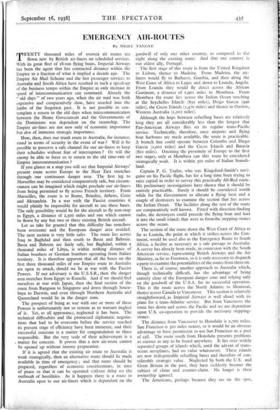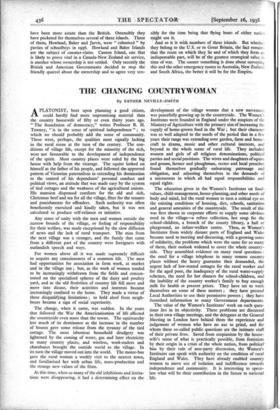EMERGENCY AIR.ROUTES
By NIGEL TANGVE
TWENTY thousand miles of oversea air routes are flown now by British air-liners on scheduled services. With its great fleet of 18-ton flying boats, Imperial Airways has been the agent that has contracted distance within the Empire to a fraction of what it implied a decade ago. The Empire Air Mail Scheme and the fast passenger services to Australia and South Africa have resulted in such a speed-up of the business tempo within the Empire as only increase in speed of .intercommunication can command. Already the "old days" of two years ago, when the air mail .was both expensive and comparatively slow, have receded into the limbo of the forgotten _ past.. It is not possible to con- template a return to the old days when intercommunication between the Home Government and the Governments of the Dominions was dependent on the steamship. The Empire air-lines are not now only of economic importance but also of immense strategic importance.
How, then, does our trunk route to Australia, for instance, stand in terms of security in the event of war ? Will it be possible to preserve a safe channel for our air-liners to keep their schedules without fear of interruption ? Or will the enemy be able to force us to return to the old time-rate of EPPire intercommunication ?
If you glance at a map you will see that Imperial Airways' present route, across Europe to the Near East stretches through one continuous danger area. The first leg to Marseilles may be considered comparatively safe, but circum- stances can be imagined which might preclude our air-liners from being permitted to fly across French territory. From Marseilles, the route is to Rome, Brindisi, Athens, Crete and Alexandria. In a war with the Fascist countries it would plainly be impossible for aircraft to use these bases. The only possibility would be for the aircraft to fly non-stop to Egypt, a distance of 2,500 miles and one which cannot be flown 'by any but two or three existing British aircraft.
Let us take for granted that this difficulty has somehow been overcome and the European danger area avoided. The next section is very little safer. The route lies across Iraq to Baghdad and then south to Basra and Bahrein. Basra and Bahrein are fairly safe, but Baghdad, within a thousand miles of Libya, is within striking distance of Italian bombers or German bombers operating from Italian territory. It is therefore apparent that all the bases on the first three thousand miles of our Empire route to Australia are open to attack, should we be at war with the Fascist Powers. If our adversary is the U.S.S.R., then the danger area stretches from Egypt to Karachi. And if we should find ourselves at war with japan, then the final section of the route from Rangoon to Singapore and down through Soura- baya to Darwin, and even through Northern Australia and Queensland would lie in the danger zone.
The prospect of being at war with one or more of these Powers is unfortunately not so remote as to warrant neglect of it. Yet, to all appearance, neglected it has been. The technical difficulties and the protracted diplomatic negotia- tions that had to be overcome before the service reached its present stage of efficiency have been immense, and their successful outcome is a matter for congratulation to those responsible. But the very scale of their achievement is a . matter for concern. It proves that a new air-route cannot be opened up without intense preparation.
If it is agreed that the existing .air route to Australia is weak strategically, then an alternative route should be made available in time of emergency ; and that route should be prepared, regardless of economic considerations, in time of peace so that it can be operated without delay on the outbreak of hostilities. As it happens there is a route to Australia open to our air-liners which is dependent on the goodwill of only one other country, as compared to the eight along the existing route. And that one country is our oldest ally, Portugal. • ' The first stage of this route is from the United Kingdom to Lisbon, thence to Madeira. From Madeira, the air- liners would fly to Bathurst, Gambia, and then along the West Coast of Africa to Lagos and down to Loanda, Angola. From Loanda they would fly direct across the African Continent, a distance of 1,903 miles to Mombasa. From Mombasa the route lies across the Indian Ocean touching at the Seychelles Islands (85o miles), Diego Garcia (990 miles), the Cocos Islands (1,470 miles) and thence to Onslow, Western Australia (1,203 miles).
• Although the hops between refuelling bases are relatively long they are all considerably less than the longest that Pan-American Airways flies on its regular trans-Pacific service. Technically, therefore, once airports and flying boat harbours are made available, the route is practicable. A branch line could operate between Colombo and Diego Garcia (i,00p miles) and the Cocos Islands and Batavia (8C3 miles). Omitting the proximity of Europe to the first two stages, only at Mombasa can this route be considered strategically weak. It is within pp miles of Italian Somali- land.
Captain P. G. Taylor, who was Kingsford-Smith's navi- gator on his Pacific flight, has for a long time been trying to raise capital in order to survey this practically All-Red route. His preliminary investigations have shown that it should be entirely practicable. Surely it should be considered worth while for the Government to allocate a flying boat and a couple of destroyers to examine the section that lies across the Indian Ocean. The facilities along the rest of the route are comparatively well known. Fitted with direction-finding radio, the destroyers could precede the flying boat and lead it into the small islands that were to form the stepping-stones across the ocean.
The section of the route down the West Coast of Africa as far as Loanda, the point at which it strikes.across the Con- tinent, would be used also as the Emergency Route to South 'Africa, a facility as necessary as a safe passage to Australia. A survey has already been made, in connexion with the South American service, representing British Airways and the Air Ministry, as far as Freetown, so it is only necessary to dispatch a party to examine the potentialities of the routes from there on.
There is, of course, another approach to Australia which, though technically difficult, has the advantage of being entirely clear of the European danger zone and relying only on the goodwill of the U.S.A. for its successful operation. This is the route across the North Atlantic to Montreal, thence across Canada to Vancouver. This section is relatively straightforward, as Imperial Airways is well ahead with its plans for a trans-Atlantic service. But from Vancouver the route lies down and across the Pacific and we are dependent upon U.S. co-operation to provide the necessary stepping- stones.
The distance from Vancouver to Honolulu is 2,700 miles. San Francisco is 303 miles nearer, so it would be an obvious advantage to have permission to use San Francisco as a port of call. The route south from Honolulu presents problems as curious as any to be found anywhere. It lies over widely separated groups of islands which, until the advent of trans- ocean aeroplanes, had no value whatsoever. These islands are now indispensable refuelling bases and therefore of con- siderable strategic value. Neglected by both the U.S. and Great Britain in the past, they have suddenly become the subject of claim and counter-claim. No longer is their ownership ignored.
The Americans, perhaps because they are on the spot, have been more astute than the British. Ostensibly they have pocketed for themselves several of these islands. Three of them, Howland, Baker and Jarvis, were " colonised " by parties of schoolboys in 1936. Howland and Baker Islands are the subject of counter-claim. Canton Island, one that is likely to prove vital in a Canada-New Zealand air service, is another whose ownership is not settled. Only recently the British and American Governments decided to stop the friendly quarrel about the ownership and to agree very sen- sibly for the time being that flying boats of either natio- might use it.
And so it is with numbers of these islands. But whethe: they belong to the U.S. or to Great Britain, the fact remain, that the route on which they lie and of which they form ar. indispensable part, will be of the greatest strategical value in time of war. The sooner something is done about surveying this and the other emergency routes to Australia, New Zealan,_ and South Africa, the better it will be for the Empire.











































 Previous page
Previous page